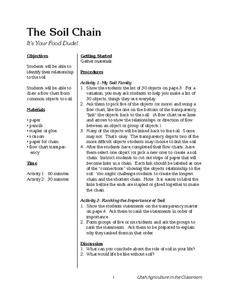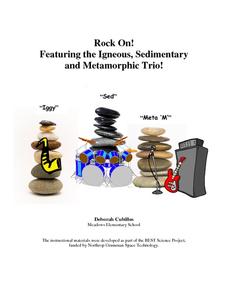Baylor College
What's Is Soil Made Of?
It's time to roll up those sleeves and get a little dirty in the second lesson of this series on the science of food. Investigate where plants and animals get the minerals they need to live in this two-part exploration of soil. First,...
Curated OER
The Soil Chain
Students identify their relationship to the soil. In this soil lesson plan, students draw a flow chart to show how common objects relate back to the soil. Students also discuss the importance of the soil.
Smithsonian Institution
Mexican War
Did you know that without the Mexican War, the United States would not include the states of Arizona, California, New Mexico, Texas, Nevada, Utah, and even parts of Colorado? Scholars learn a variety of interesting facts about the...
Curated OER
Soil Layers
Ninth graders identify the different layers of soil. In this earth science lesson, 9th graders explain how limestone layers are formed. They identify the different parts of the coral colony.
Calvin Crest Outdoor School
Survival
Equip young campers with important survival knowledge with a set of engaging lessons. Teammates work together to complete three outdoor activities, which include building a shelter, starting a campfire, and finding directions in the...
Curated OER
Explor-A-Pond: 5th Grade Soil Erosion
Fifth graders compare and contrast the rate of soil erosion along water and along a vegetation area. They observe the differences and record their information and write a hypothesis of what they think happen if the erosion continues.
Curated OER
Is Soil Alive?
Third graders observe soil samples. They then form hypotheses as to whether or not soil is alive. Students read and discuss information about soil and components of soil. They state wheter or not they believe soil is alive and list...
Curated OER
Land Use Issues
Students examine soil types and determine the ability of each to absorb water. Working in groups, they time how long it takes for water to seep out the bottom of the cups. They examine soil components, conservation, erosion, and tree...
Curated OER
WET Science Lesson #3: Comparison of Aquatic and Terrestrial Plants
Elementary life science explorers compare and contrast aquatic and terrestrial plants (elodea and soybeans) in a Venn diagram. Some background information is provided to support direct instruction, and general instructions are provided...
Curated OER
Keeping Soil in Its Place - Slip Slidin' Away
Students experiment to show rain drop splash and splash erosion. In this erosion lesson, students complete 3 experiments showing splash erosion and methods for controlling soil erosion. They complete a number of worksheets, learn...
Baylor College
Needs of Plants
What better way to learn about plant life than by creating a class garden? Young botanists start with a brief discussion about radishes before planting seeds and watching them grow. To determine the importance of water,...
Curated OER
Erosion
Fifth graders engage in some activities that will help them to identify erosion and explain the causes of erosion. They also look into ways that humans can slow the process of erosion in some cases. After a teacher-led demonstration,...
Curated OER
Hoot: Vocabulary: Magic Squares
Define words with numbers in a fun vocabulary activity. Using words from Hoot by Carl Hiaasen, learners use a grid to match words and their definitions, and to find the magic number that is the same when the numbers are added from...
Curated OER
Composting
Using 2-liter bottles, junior ecologists create composting tubes in which they place nitrogen-rich and carbon-rich materials. They observe what changes occur over two weeks' time. Provide more specific direction to your class as to what...
Curated OER
Understanding Volcanoes
Learners create a model volcano in groups, and discuss what each part of the model represents as they go along. In this volcano lesson, students come back together as a whole group and discuss what group did the best work,...
University of Wisconsin
Rain Garden Species Selection
The activity really comes to life within its intended unit on starting a rain garden. Working in groups, participants research native plants and coordinate them with the conditions in the designated garden area. Give the class access to...
DiscoverE
A Clever Way to Water
Your plants will survive without you. Scholars create a device that can water plants using a coiled string. Along the way, they learn about adhesion and cohesion of water. The challenge is to keep the plants alive for at least a week.
California Education Partners
Science Fair Project
Plant the data firmly on the graph. Given information about the growth rate of plants, pupils determine the heights at specific times and graph the data. Using the information, scholars determine whether a statement is true and support...
Curated OER
Rock On! Featuring the Igneous, Sedimentary and Metamorphic Trio!
Get your classroom rocking with this four-lesson earth science unit. Through a series of shared reading activities and hands-on investigations, young geologists learn about the three types of rocks and the unique properties of each.
Alabama Learning Exchange
Where is the Dirt? A Lesson in Hydroponics
Students use the Internet to research hydroponic gardening which is the growing of plants without soil. They participate in an experiment where a hydroponic garden is contructed in the classroom for observaion. They recorde information...
Curated OER
Sunlight and Plants
Students design and conduct an experiment to discover the role of direct sunlight on plants during germination and after germination. They plant corn and lima beans in small containers which they place in direct sunlight from a window...
Curated OER
Erosion
Fifth graders study what erosion is, what causes it, and ways to slow its progress. They complete an experiment that depicts soil moving down a slope as water is poured on it to show how moving water erodes land. Next, they observe...
Curated OER
Station: Earth's Interior
In this earth science worksheet, learners cut out each die pattern and the signs for each station. Then they assemble the dice by folding along lines and taping the edges together. Students also follow the written instructions for...
Curated OER
Observing The Influence Of Acid Rain On Plant Growth
Students observe one of the direct effects of acid water on plant growth. Students engage in an experiment which will take about 2 weeks. Students will understand the effect that acid rain has on plant growth.























